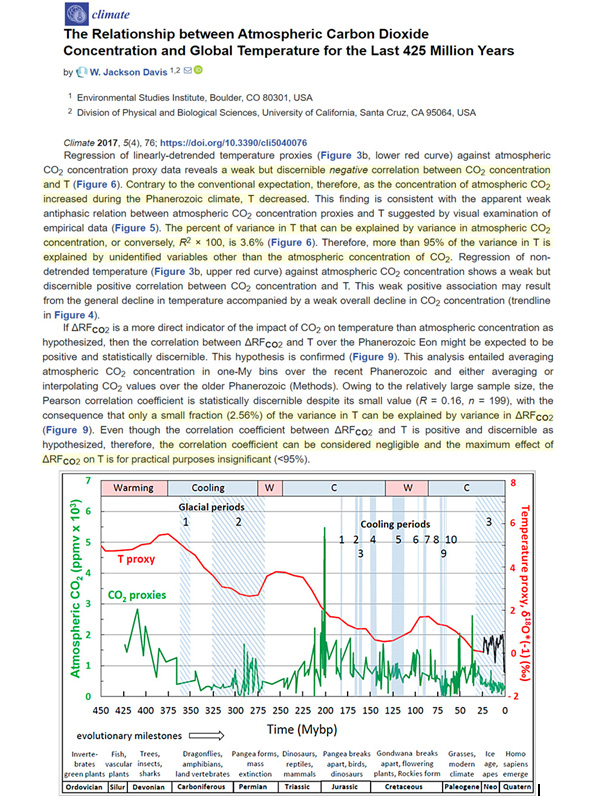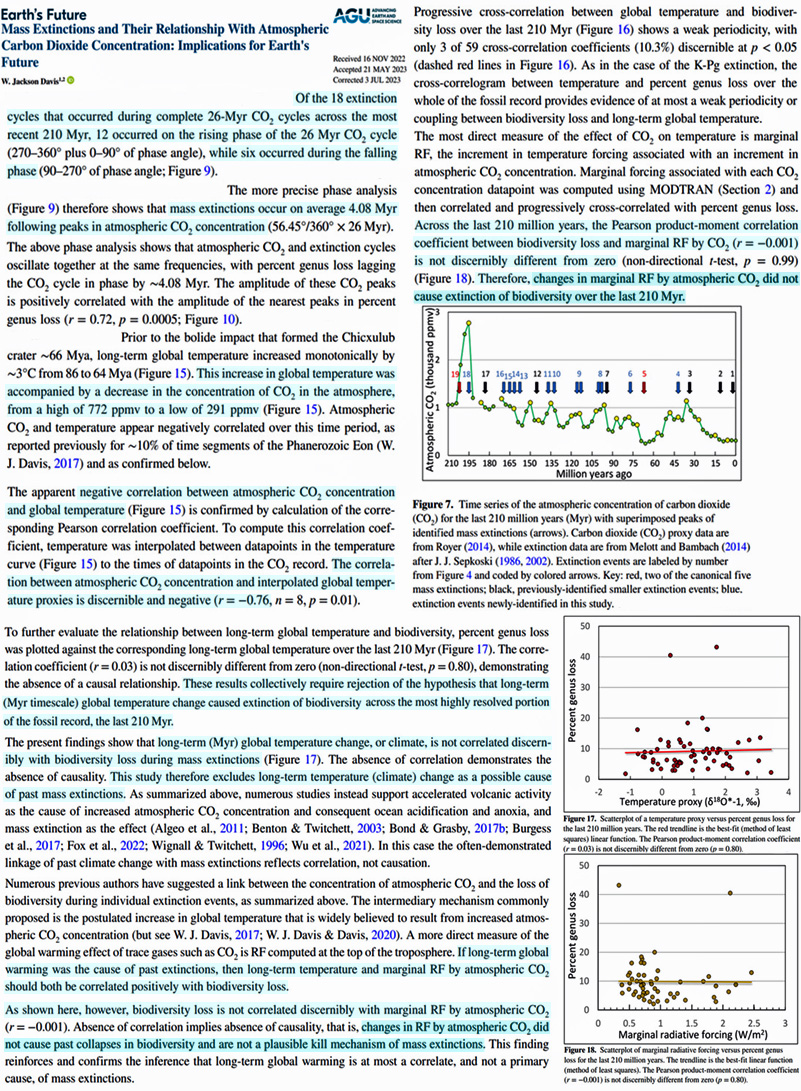Over the last 210 million years [Myr], (a) CO2 falls as temperatures rise (negative correlation, r = -0.76), (b) mass extinctions occur 4.08 Myr after CO2 peaks, and (c) global warming/CO2 radiative forcing “did not cause extinction of biodiversity.”
A new study has been published in Earth’s Future journal that supplements a 2017 analysis of hundreds of millions of years of CO2 and temperature variations.
Davis (2017) argued that for 97.44% of the last 425 Myr there was either a negative correlation (CO2 falls, temperatures rise or CO2 rises as temperatures fall) or no correlation at all between variations in global temperatures and radiative forcing by atmospheric CO2. In other words, the IPCC-proposed link between the rise in atmospheric CO2 as the causal mechanism and global warming could only explain 2.56% of the variance in the long-term paleoclimate record.

Image Source: Davis, 2017
A positive correlation between high CO2 and extinctions
But now a new study by the same author looks at the timing of mass extinctions and their correspondence with atmospheric CO2 concentrations over the last 210 Mya. There were reportedly 12 mass extinction events that occurred when CO2 was rising to peak levels (~1,000 ppm) during this period, whereas 6 occurred as CO2 was falling. This is considered a weakly positive correlation.
Interestingly, though, the timing for the mass extinctions was, on average, 4.08 Myr after the CO2 levels had reached their apex. This leads one to question why it would be thought the effect (mass extinctions) should lag the triggering cause (peak CO2) by millions of years. Especially since species extinctions can occur in time spans of decades to centuries.
A negative correlation between global warming and atmospheric CO2
As he did in his previous paper, Davis (2023) documents an overall negative correlation between global temperatures and atmospheric CO2 concentrations over the last 210 Mya. Specifically, multiple degrees of increases in global temperatures occurred as CO2 levels fell (for example, from 772 ppmv to 291 ppmv).
“The correlation between atmospheric CO2 concentration and interpolated global temperature proxies is discernible and negative (r = −0.76, n = 8, p = 0.01).”
Since the correlation between CO2 and global temperature is more often negative than positive, the positive link between high CO2 levels and extinctions Davis addresses in his study could be explained as a better correlation with high CO2 and global cooling than with high CO2 and global warming.

Image Source: Davis, 2023
Neither global warming or CO2 radiative forcing caused past mass extinctions
Over the last 210 Myr, the correlation between global warming periods and mass extinctions is “not discernibly different from zero” (r = 0.03), and the correlation between atmospheric CO2 radiative forcing (RF) is also “not discernibly different from zero” (r = -0.001). Without correlation, there can be no causal relationship between either global warming or CO2 radiative forcing and the record of mass extinctions.
“These results collectively require rejection of the hypothesis that long-term (Myr timescale) global temperature change caused extinction of biodiversity across the most highly resolved portion of the fossil record, the last 210 Myr.”
“This study therefore excludes long-term temperature (climate) change as a possible cause of past mass extinctions.”
“If long-term global warming was the cause of past extinctions, then long-term temperature and marginal RF by atmospheric CO2 should both be correlated positively with biodiversity loss. As shown here, however, biodiversity loss is not correlated discernibly with marginal RF by atmospheric CO2…that is, changes in RF by atmospheric CO2 did not cause past collapses in biodiversity and are not a plausible kill mechanism of mass extinctions.”





Recent Comments